Disclosure: Please note that some links are affiliate links, and at no additional cost to you, we earn a commission if you make a purchase.
If you would like to support this website in some way, using these links will help do exactly that.
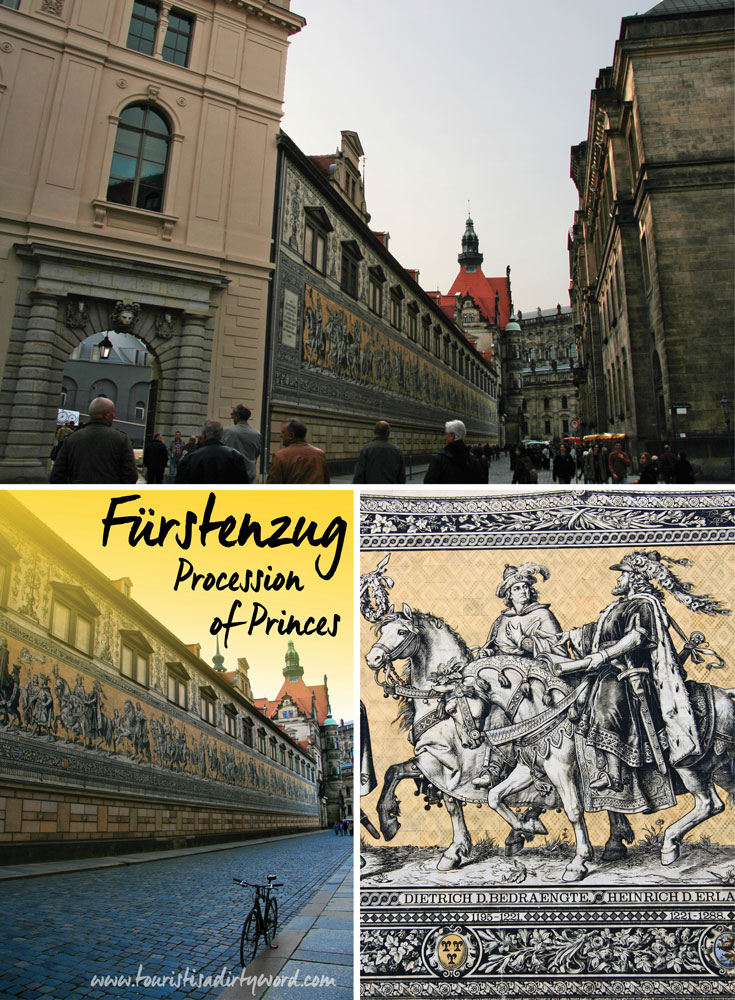
We knew we were getting closer as there were more souvenir kiosks with the mural on anything and everything you could think of. We turned the corner, and my jaw dropped. Wait! What? It was HUGE! In my travel guide there had only been perhaps 5% of the mural reproduced, and it was without any contextual clues for scale. This mural took up almost the entire side of the building, and it stretched down the entire block, all the way to the castle square.
It was still early in the morning, and the street beside the mural was shockingly vacant. There was just one lone bicycle chained up. Perfect. The Procession of Princes, the Fürstenzug, reminded me vaguely of the opening sequence to Disney’s animated feature Robin Hood (1973), where there’s a parade of nobility and squires in period dress proceeding through the opening credits. I wonder if this is where the animated had received their inspiration?
To celebrate the anniversary in 1889 of 800 years of the rule of the House of Wettin, a new fresco was commissioned to replace one with limewash existing for three hundred years (since 1589) that was nearly invisible on the outer wall of the Stables Courtyard.
Wilhelm Walther (1826-1913) used the sgraffito, from the Italian word graffiare meaning to scratch, technique on stucco, to provide more detail. I have not been able to discover why Wilhelm Walther was chosen for this work, or much about the artist in general. He includes himself as a self portrait at the end of the mural. If you know of any resources on him in English, please let me know in the comments below.
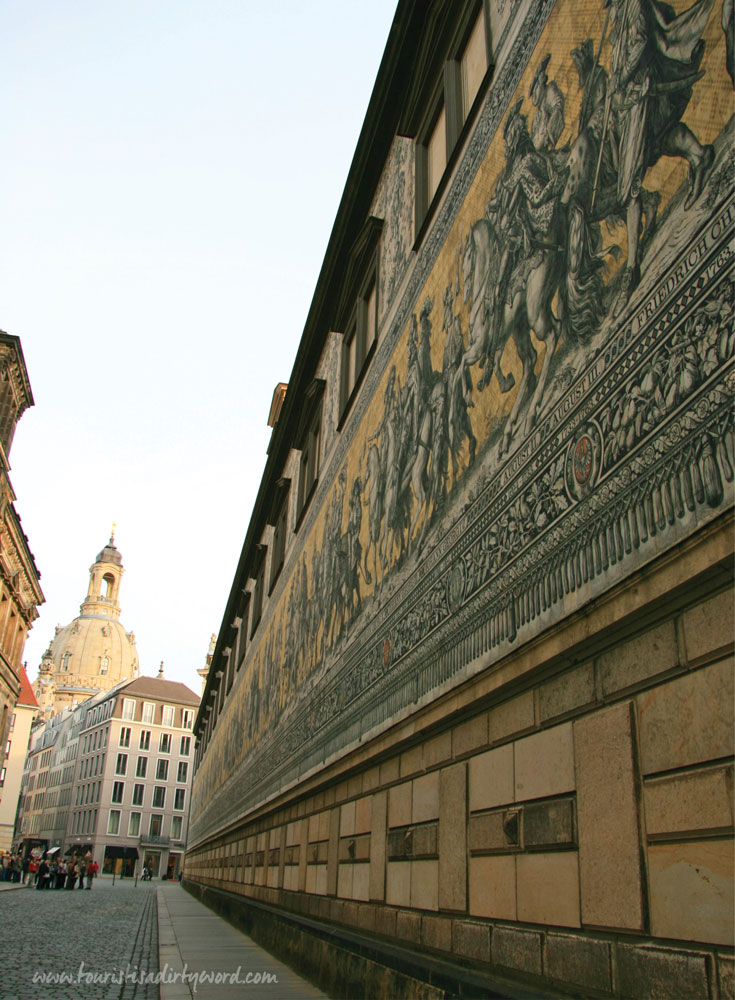
The mural is a visual timeline of almost all the rulers between 1127 until 1904, thirty-five rulers in all, each in their own time period’s costume, mounted on a horse. There are fifty-nine walking figures representing various walks of life, farmers, children, etc. There is only one girl in the entire mural, look for a little girl at the end of the procession. The gentleman at the very, very end with the beard is the artist Wilhelm Walther.
This new mural deteriorated very quickly, and only twenty-eight years later, the painting was replaced with the same design, but utilizing over twenty thousand Meissen porcelain tiles. At three hundred and thirty-five feet long, it is known as the largest porcelain artwork in the world. By some wonderful stroke of luck, the porcelain tiles only suffered minimal damage during the February 13-15, 1945 city-wide bombing of Dresden.
Hopefully third time's a charm for the mural! Again, if you know anything else about the artist Wilhelm Walther, please fill us in! I'd love to learn more. Tell us in the comments below.
Follow Along
If you enjoyed this article, you'll love our weekly newsletter. You'll receive a free Germany Packing list for signing up, and you'll receive each week's newest posts every Friday. Thank you for reading!
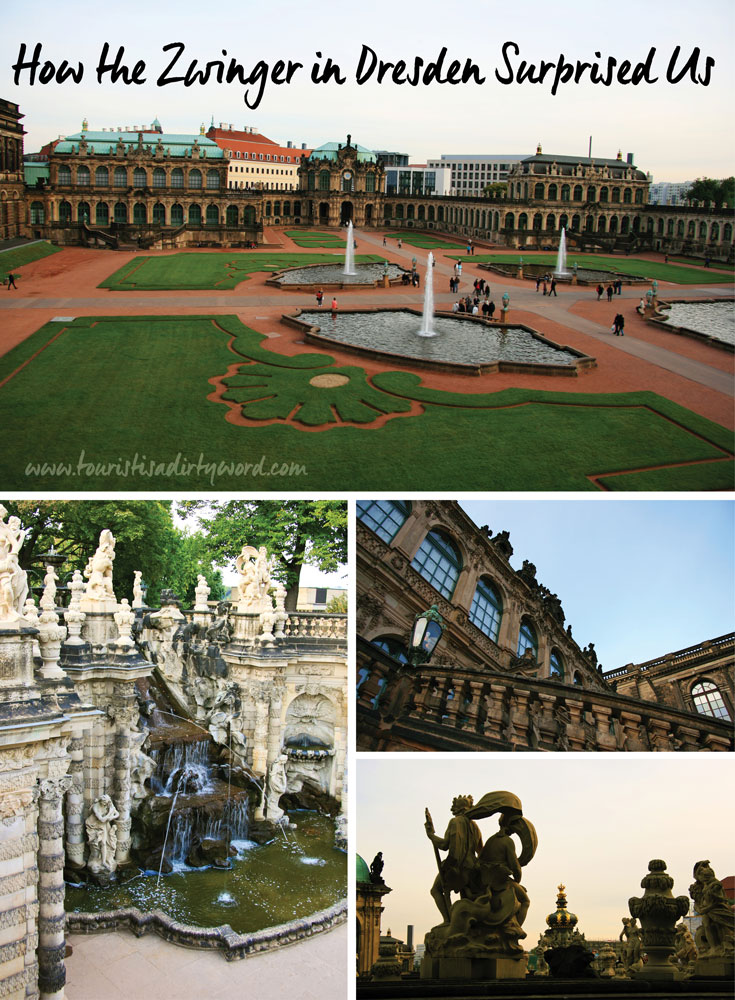
We were lost, but happily lost. There was a tour group up high above the galleries, and we wandered towards them looking for the way up. Upon discovering an exterior staircase, we hustled up top to see if we could surprise Sebastian’s parents and sister. It worked! Calling out to them down below in the gardens, they laughed and had the same inquisitive, puzzled looks we had when we saw the tour group up here. It wasn’t long until his sister had joined us. The view was worth climbing the stairs.
I was surprised that not only could you climb to the top of the galleries, but there were also sculptures and decoration up there. The reason for this was for the view of the gardens and to serve as ‘grandstands’ for Augustus the Strong’s beloved festivals, pageants, processions and tournaments. The Zwinger was even inaugurated in 1719 with Augustus’ son’s wedding to the Habsburg emperor’s daughter in this garden. The architect for the Zwinger complex, Matthäus Daniel Pöppelmann, aimed to create contrast with the flat ceilings of the galleries, doubling as grandstands, with fancy, sculptural projecting gates and pavilions. This is where sculpture and architecture become gorgeously entangled, namely in the Wallpavillon with its glockenspiel of Meissen porcelain bells, the blue copper and gilded crown of the Kronentor and Nymphenbad, all sculpted under Balthasar Permoser’s direction.
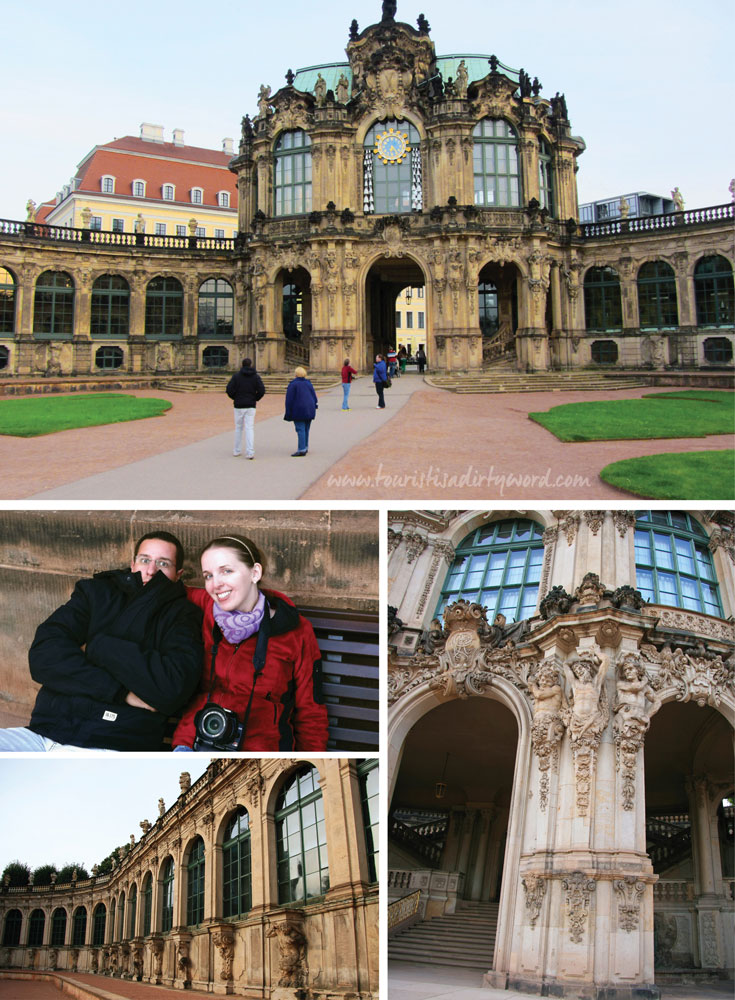
We could stay all day and still not see everything. The Zwinger and Semper complex houses three museums, beyond being an attraction as an exquisite example of Baroque architecture and garden delights in its own right. Sebastian’s Mom advocated strongly for us to visit the Zwinger’s Porcelain Museum, and we briefly ventured into the Old Masters Gallery for the sole purpose of hunting down Johannes Vermeer’s ‘Girl Reading a Letter by an Open Window’.
Mind-boggling Porcelain
Check out this video from the Staatliche Kunstsammlung Dresden, and while yes parts of it are only in German, patiently wait for New York architect Peter Marino’s multiple charming interviews where he explains his vision for the interior decorating of the Porcelain Museum. Also, I have to recommend again that you listen to the BBC Radio 4 Podcast Episode “Porcelain: The White Gold of Saxony” for a great retelling of August the Strong’s obsessive preoccupation with porcelain and the surprising story of how it came to be made in Saxony. You’ll meet the porcelain rhino who is explained in length in this podcast episode.
The Animal Hall was my favorite because the animals felt like they were enchanted, frozen in porcelain. Yet, the animals were rendered in a way as to be illustrations from someone’s imagination, rather than absolute anatomically perfect representations. I also loved the porcelain flower bouquets, as most who lament that all flowers must die at some point, these would live forever.
I was fascinated by this real world example of faking it until you make it; the Meissen porcelain makers copied their inspiration, the Asian style of porcelain, until they mastered the craft. Then they went on to fashioning a whole new world of porcelain that was uniquely Meissen.
Meeting the Girl Reading a Letter by an Open Window
Even I have a limit for how much artwork I can visually consume before I’m overloaded. We visited the Albertinum the day before, and coming from the stunning Porcelain Museum, I was becoming mentally overwhelmed. But, knowing that one of Johannes Vermeer’s masterpieces was so close, I couldn’t NOT see it. Part of my heart would break. So we made this portion of our visit to the Zwinger a bit of a scavenger hunt.
I’m always so surprised at how small Vermeer’s works are, but they still take my breath away. There is yet to be a way of reproducing paintings in books that will ever come close to the viscosity and life of the real thing. Printed drops of ink per inch in a book can never truly capture the richness of color and brush work as the real thing. Vermeer’s works are sore examples of this fact. His work is always so tiny, that it's no wonder that printed reproductions of them are so misleading. Case in point of why it's so important to visit the real paintings. It was worth the effort, and while we were all exhausted and swaying on tired feet, we stood together in front of ‘Girl Reading a Letter by an Open Window’ and didn’t say a word, soaking it in. Eyes watering with joy. She was worth it.
Bonus Resources
Goodies of knowledge that helped with this post
• History Time The Staatliche Kunstsammlungen Dresden Website has a great synopsis of the history of the Zwinger and Semper building, I didn’t see a reason to rephrase it.
• Listen to the BBC Radio 4 Podcast Episode “Porcelain: The White Gold of Saxony” for a great retelling of August the Strong’s preoccupation with porcelain and how it came to be made in Saxony.
• Preview your experience through the Museum's official high-resolution 360 degree panoramas.
• Sneak a peek at the museums' holdings through Google's Art Project, available for all 3 museums:
Not mentioned in this post, but also part of the Zwinger Complex, the Royal Cabinet of Mathematical & Physical Instruments
• Read The Fairest of Them All: The Dresden State Art Collections by Jens-Uwe Sommerschuh, my choice for a souvenir.

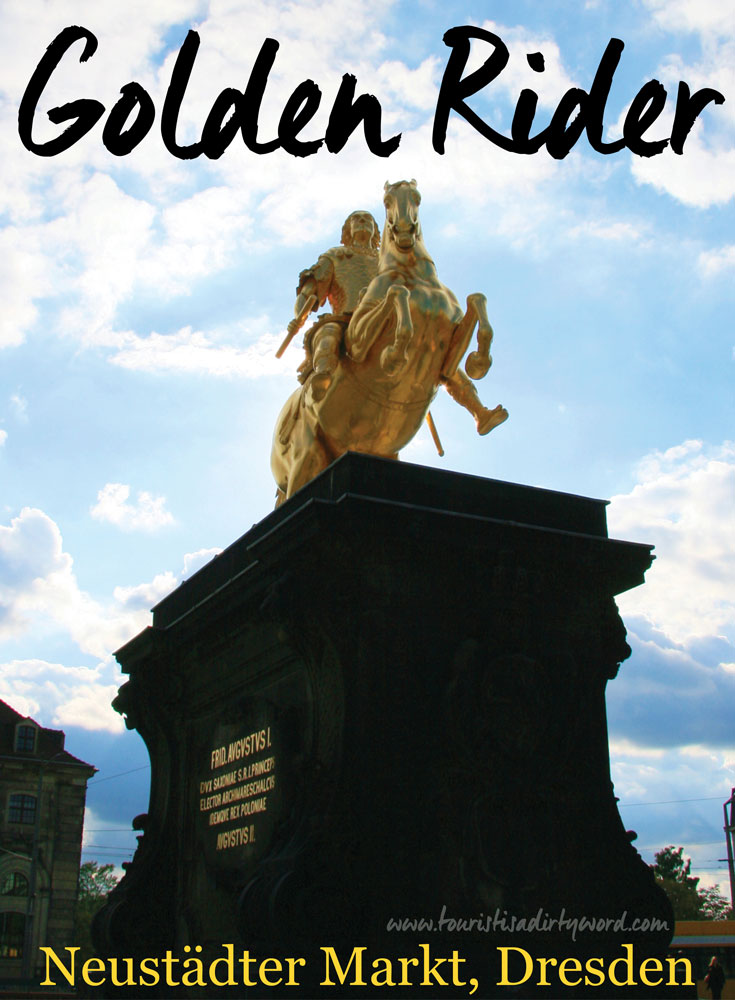
If you are looking for the most well known historical statue in Dresden, follow the golden shimmer and look down the tree-lined alley in the Neustadt district. At the end of that alley you will spot the golden, extravagant statue of Augustus II the Strong (1670–1733) in full body armor on a horse.
Who is the Man on the Horse?
Augustus II the Strong, the Elector of Saxony from 1694-1733, loved the arts, and the wealth and status the arts advertised. He fashioned the Saxon capital city of Dresden into a baroque gem through his numerous building projects he started and his extensive collection of treasures. Why is 'the Strong' part added to his name? The story goes that Augustus II could bend horseshoes with his bare hands, excelled in fox tossing (which is as horrible to foxes as it sounds), was above average height for the time at almost six feet, and supposedly sired hundreds of children.
The Story of the Statue
Upon the death of Augustus the Strong, his son Augustus III collaborated with his father’s court sculptor Jean-Joseph Vinanche on a memoriam equestrian statue. Vinanche designed the statue showcasing Augustus the Strong as larger than life. Then the design was cast by Ludwig Wiedemann from Augsburg. The statue is actually made out of copper covered in gold foil. The statue was unveiled in 1736 in the square of Neustädter Markt next to the Augustusbrücke, meaning Bridge of Augustus, with the statue facing towards Poland, where he reigned twice, 1697 to 1704, and re-elected 1709 until his death in 1733.
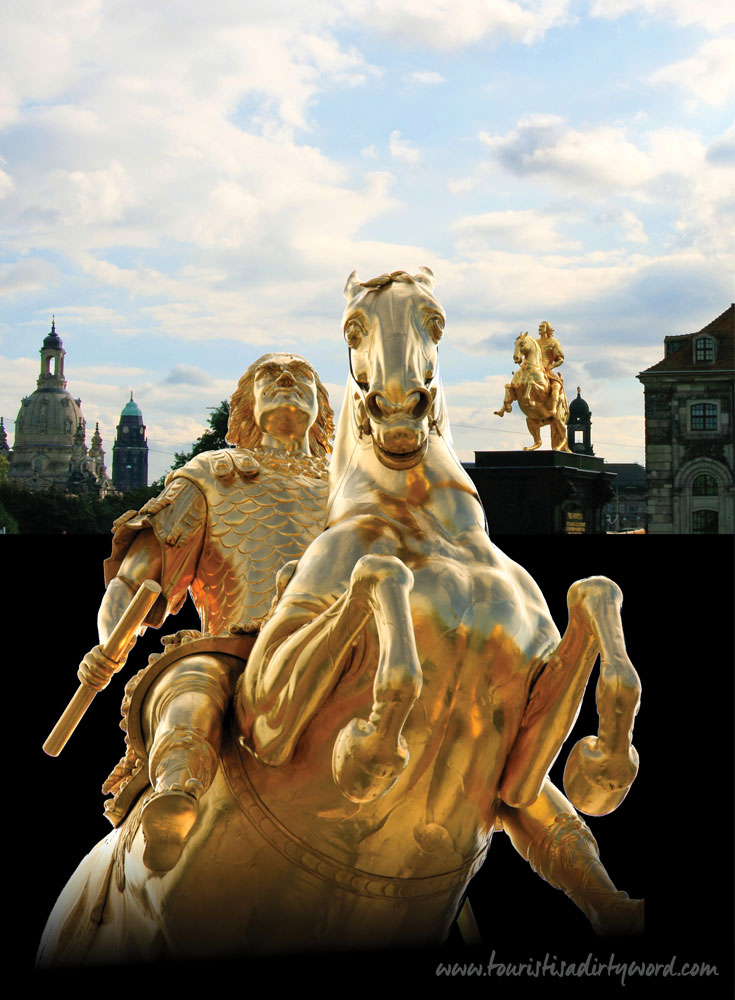
Equestrian Statues as Status Symbols
Equestrian statues are challenging to create because of the amount of weight and support that must be maintained by four, sometimes two if the horse is rearing, slender horse legs. In the Golden Rider, the horse is rearing on its back legs, but you’ll notice there is additional weight support through the horse’s tail. Equestrian statues representing rulers were far from being an innovative idea. It was yet another token of accomplishment that ‘Yes, we too can create that complicated type of sculpture at our court.’
WWII and Today
The statue survived the 1945 city-wide bombing hidden in a secret place, and was not returned to its original position until 1956, where it stands today. The statue has become a symbol of Dresden. Keep your eyes open when you are in a Dresden supermarket, because this landmark is not only pictured on certain beer bottles, but also graces a golden seal on a brand of Dresden Christmas cake called Stollen, basically a sweet yeast loaf with fruits and almonds.

